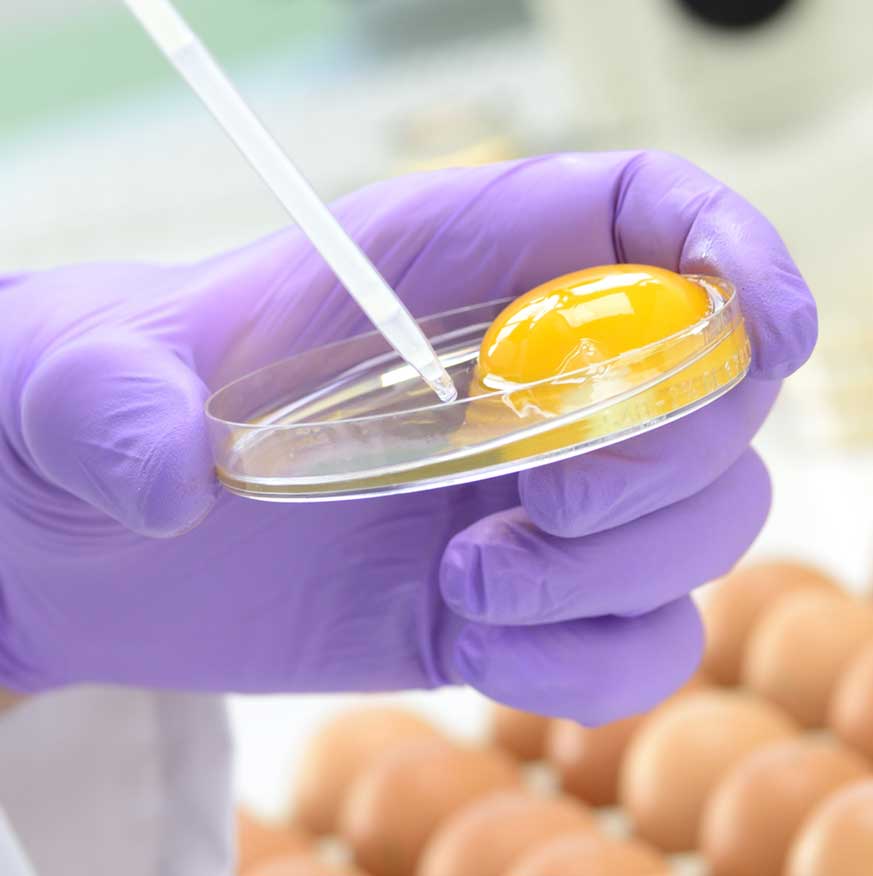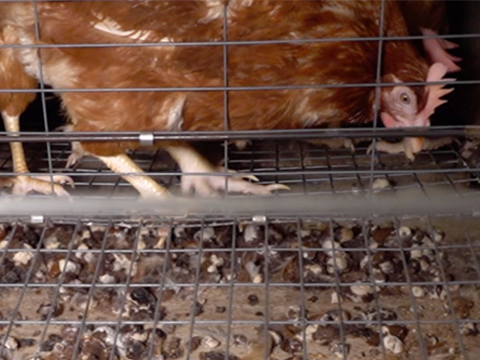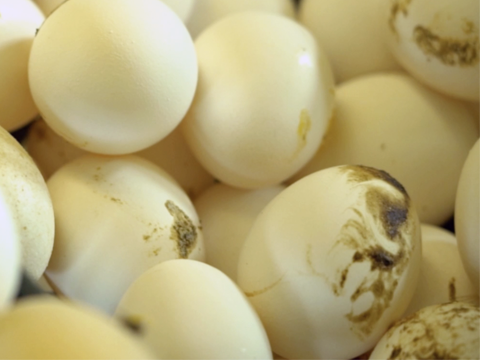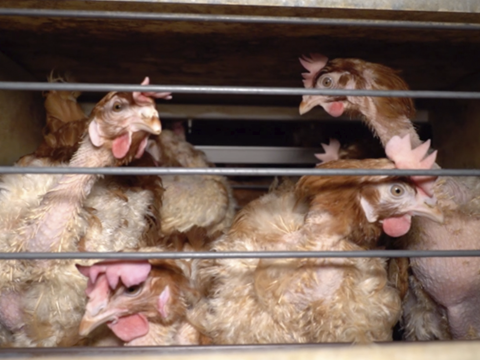
القذارة و القسوة على الحيوان من قبل صابواي
نظرة صادمة على سلسة توزيع البيض الخاصة بصابواي
هل تأكل في المطاعم التي تديرها صابواي ؟ إذا كان كذلك، يجب عليك التفكير مرة أخرى، هناك فيديو صادم يكشف أخطار متعلقة بسلامة الطعام إضافة إلى .
القسوة الشديدة على الحيوان وراء البيض المستعمل في صابواي. صابواي تستمر في استعمال بيوض قفص البطارية القذرة و القاسية في جنوب آسيا و الشرق الأوسط.
. في المزارع التي تحجز الدجاج في الأقفاص، الفضلات و القذارة تكسو قضبان الأقفاص حيث يتم وضع البيوض، و الفضلات تتراكم على بعد إنشات قليلة من البيوض و من الطيور نفسها. الدجاجات الأم تُحشرتقريبا طوال حياتها في أقفاص صغيرة و قاسية و هذا غير قانوني في عشرات البلدان حول العالم. جثث الدجاج الميت تترك لتتحلل بجانب الدجاج الواضع للبيوض المستهلكة من طرف الإنسان
عشرات من المطاعم الرائدة الأخرى قد أعطت إلتزامات لاستعمال البيوض الخالية من الأقفاص فقط في جميع أنحاء آسيا و عالميا. على سبيل المثال ستاربكس، بري ا مونجي، سالادستوب، كوستا كوفي، شايك شاك و بورغر كينغ كلها أعطت إلتزامات ببيوض مئة بالمئة خالية من الأقفاص في آسيا، بعضها عالميا، كما فعلت أكثر من خمسين شركة طعام رائدة أخرى. لكن يبدو أن صابواي تعتقد أن زبائنها في جنوب آسيا و الشرق الأوسط لا يستحقون نفس المعاملة. فهم يواصلون بيع بيوض من مزارع بيوض أقفاص قذرة و قاسية من دون أي تعهد بالتغيير.
حان الوقت لتلتحق صابواي بسلسلة المطاعم العالمية الرائدة الأخرى و ذلك بتحديد وقت لبيع بيوض بدون أقفاص فقط
يرجى التوقيع على العريضة !
صب واي: لن أتناول الطعام في أي من مطاعمك حتى تنضم إلى شركات الأغذية الرائدة الأخرى وتلتزم بوقف استخدام أقفاص البطاريات المتسخة والقاسية. حان الوقت لنقل مترو الأنفاق إلى قفص 100٪!

أخطار بيض الأقفاص على سلامة الغذاء
لقد وجدت عشرات الدراسات العلمية أن مزارع بيوض الأقفاص لديها معدلات أعلى بشكل كبير لتلوث السالمونيلا. لقد أجرت هيئة سلامة الغذاء الأوروبية أكبر دراسة حول المشكل، محللة بيانات من خمسة آلاف مزرعة. و وجدت أن مزارع بيوض الأقفاص تكون خمسا و عشرين مرة أكثر عرضة للتلوث بسلالات السالمونيلا الرئيسية (1, 2, 3, 4, 5, 6, 7, 8, 9, 10, 11, 12, 13, 14, 15, 16, 17)
هنالك عدة أسباب تجعل حشو الدجاج في الأقفاص يسبب مخاطر على سلامة الغذاء. تظهر أبحاث وزارة الزراعة الأمريكية أن الضغط الناتج عن الحبس في الأقفاص يجعل الدجاج أكثر عرضة للمرض. إضافة إلى ذلك فالأقفاص صعبة التنظيف و التطهير، مما يؤدي إلى “حجم أكبر من المادة البرازية الملوثة إضافة إلى الغبار.” (18, 19, 20, 21, 22, 23)
بيوض الأقفاص قاسية
مثل الكلاب و القطط، الدجاج مخلوقات ذكية تحس بالمتعة و الألم. حبس حيوان في قفص صغير لدرجة أنه لا يستطيع حتى الإلتفات طوال حياته تقريبا هو بكل بساطة خاطئ. (24)
أقفاص البطارية قاسية جدا لدرجة أنها مُنعت في عشرات البلدان حول العالم. تعتبر كل منظمة سامية لحماية الحيوان حول العالم أقفاص البطارية قاسية و غير إنسانية. (25, 26, 27)
هذا ما قالته بعض هذه المنظمات :

“تدعو الجمعية الملكية للحول دون القسوة على الحيوانات إلى حظر جميع أنظمة الأقفاص…و حفظ الدجاج الواضع للبيض في أنظمة بديلة مدارة بعناية.”
الجمعية الملكية للحول دون القسوة على الحيوان

“الحبس الشديد للحيوانات في المزارع هو فعل بربري و لا يتماشى مع القيم المعاصرة”
الجمعية الأمريكية للحول دون القسوة على الحيوانات

“الدجاج في الأقفاص أكثر عرضة للضغط و الأذى، إضافة إلى زيادة خطر الإصابة بالسالمونيلا.”
حماية الحيوان في العالم
هته المنظمات غير متعاقدة مع هذا الموقع

أقفاص البطارية
صابواي تواصل بيع بيوض الممونين الحابسين للدجاج في أقفاص البطارية القذرة و القاسية للزبائن

قذر
في هؤلاء الممونين الخاصين بصابواي، تغطي الفضلات المعدات و تقوم بتلطيخ البيض

قاسي
كل دجاجة أم تقضي معظم حياتها معبأة في قفص صغير لدرجة أنها لا تستطيع الإلتفاف
التنزيلات و التوثيق
إيكويتاسهي منظمة عالمية غير ربحية مقرها في المملكة المتحدة وتعمل على حماية المستهلك والحيوان في سلاسل التوريد الغذائي حول العالم.
إقتباسات عن مخاطر سلامة الغذاء و قسوة أقفاص البطاريات على الحيوانات :
1: Van Hoorebeke S, Van Immerseel F, Schulz J, et al. 2010. Determination of the within and between flock prevalence and identification of risk factors for Salmonella infections in laying hen flocks housed in conventional and alternative systems. Preventive Veterinary Medicine 94(1-2):94-100.
2: Snow LC, Davies RH, Christiansen KH, et al. 2010. Investigation of risk factors for Salmonella on commercial egg-laying farms in Great Britain, 2004-2005. Veterinary Record 166(19):579-86.
3: 2010. Annual Report on Zoonoses in Denmark 2009. National Food Institute, Technical University of Denmark.
4: Van Hoorebeke S, Van Immerseel F, De Vylder J et al. 2010. The age of production system and previous Salmonella infections on farm are risk factors for low-level Salmonella infections in laying hen flocks. Poultry Science 89:1315-1319.
5: Huneau-Salaün A, Chemaly M, Le Bouquin S, et al. 2009. Risk factors for Salmonella enterica subsp. Enteric contamination in 5 French laying hen flocks at the end of the laying period. Preventative Veterinary Medicine 89:51-8.
6: Green AR, Wesley I, Trampel DW, et al. 2009 Air quality and bird health status in three types of commercial egg layer houses. Journal of Applied Poultry Research 18:605-621.
7: Schulz J, Luecking G, Dewulf J, Hartung J. 2009. Prevalence of Salmonella in German battery cages and alternative housing systems. 14th International congress of the International Society for Animal Hygiene: Sustainable animal husbandry : prevention is better than cure. pp. 699-702. http://www.safehouse-project.eu/vars/fichiers/pub_defaut/Schulz_Salmonella_ISAH%202009.ppt.
8: Namata H, Méroc E, Aerts M, et al. 2008. Salmonella in Belgian laying hens: an identification of risk factors. Preventive Veterinary Medicine 83(3-4):323-36.
9: Mahé A, Bougeard S, Huneau-Salaün A, et al. 2008. Bayesian estimation of flock-level sensitivity of detection of Salmonella spp. Enteritidis and Typhimurium according to the sampling procedure in French laying-hen houses. Preventive Veterinary Medicine 84(1-2):11-26.
10: Pieskus J, et al. 2008. Salmonella incidence in broiler and laying hens with the different housing systems. Journal of Poultry Science 45:227-231.
11: European Food Safety Authority. 2007. Report of the Task Force on Zoonoses Data Collection on the Analysis of the baseline study on the prevalence of Salmonella in holdings of laying hen flocks of Gallus gallus. The EFSA Journal 97. www.efsa.europa.eu/EFSA/efsa_locale-1178620753812_1178620761896.htm.
12: Snow LC, Davies RH, Christiansen KH, et al. 2007. Survey of the prevalence of Salmonella species on commercial laying farms in the United Kingdom. The Veterinary Record 161(14):471-6.
13: Methner U, Diller R, Reiche R, and Böhland K. 2006. [Occurence of salmonellae in laying hens in different housing systems and inferences for control]. Berliner und Münchener tierärztliche Wochenschrift 119(11-12):467-73.
14: Much P, Österreicher E, Lassnig. H. 2007. Results of the EU-wide Baseline Study on the Prevalence of Salmonella spp. in Holdings of Laying Hens in Austria. Archiv für Lebensmittelhygiene 58:225-229.
15: Stepien-Pysniak D. 2010. Occurrence of Gram-negative bacteria in hens’ eggs depending on their source and storage conditions. Polish Journal of Veterinary Sciences 13(3):507-13.
16: Humane Society International, “An HSI Report: Food Safety and Cage Egg Production” (2010). HSI Reports: Farm Animal Protection. 3. http://animalstudiesrepository.org/hsi_reps_fap/3
17: European Food Safety Authority. 2007. Report of the Task Force on Zoonoses Data Collection on the Analysis of the baseline study on the prevalence of Salmonella in holdings of laying hen flocks of Gallus gallus. The EFSA Journal 97. www.efsa.europa.eu/EFSA/efsa_locale-1178620753812_1178620761896.htm
18: The Danish Veterinary and Food Administration. 2004. The national Salmonella control programme for the production of table eggs and broilers 1996-2002. Fødevare Rapport 6, March.
19: Davies R and Breslin M. 2003. Observations on Salmonella contamination of commercial laying farms before and after cleaning and disinfection. The Veterinary Record 152(10):283-7.
20: Methner U, Rabsch W, Reissbrodt R, and Williams PH. 2008. Effect of norepinephrine on colonisation and systemic spread of Salmonella enterica in infected animals: Role of catecholate siderophore precursors and degradation products. International Journal of Medical Microbiology 298(5-6):429-39.
21: Bailey MT, Karaszewski JW, Lubach GR, Coe CL, and Lyte M. 1999. In vivo adaptation of attenuated Salmonella Typhimurium results in increased growth upon exposure to norepinephrine. Physiology and Behavior 67(3):359-64.
22: Shini S, Kaiser P, Shini A, and Bryden WL. 2008. Biological response of chickens (Gallus gallus domesticus) induced by corticosterone and a bacterial endotoxin. Comparative Biochemistry and Physiology. Part B. 149(2):324-33.
23: Rostagno MH. 2009. Can stress in farm animals increase food safety risk? Foodborne Pathogens and Disease 6(7):767-76.
24: Marino, L. 2017. Thinking chickens: a review of cognition, emotion, and behavior in the domestic chicken. Animal Cognition 20(2): 127–147.
25: “European_Union_Council_Directive_1999/74/EC.” Wikipedia: The Free Encyclopedia. Wikimedia Foundation, Inc. Web 03 August 2018, en.wikipedia.org/wiki/European_Union_Council_Directive_1999/74/EC
26: “Farm Animal Confinement Bans.” American Society for the Prevention of Cruelty to Animals. Web. 03 August 2018, www.aspca.org/animal-protection/public-policy/farm-animal-confinement-bans
27: World Organization for Animal Health, “Terrestrial Animal Health Code” (2017). www.rr-africa.oie.int/docspdf/en/Codes/en_csat-vol1.pdf


